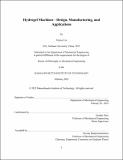| dc.description.abstract | Hydrogels are polymer networks infiltrated with water. Natural hydrogels constitute the major components of the human body such as muscles and cartilages; and synthetic hydrogels have been widely used in applications that closely interact with biological organisms, ranging from tissue engineering, drug delivery, and contact lenses to sensors, actuators, electronics, optics, and other soft machines. As many living tissues undergo dynamic and repeating deformation, natural hydrogels have achieved the extreme mechanical robustness necessary for their survival and wellbeing through evolution. Mechanical properties of synthetic hydrogels are also required and play crucial roles in maintaining the integration and functionality of hydrogel machines, especially when they interact with the dynamic tissues and organs. In this thesis, I first report the design and manufacturing of tough, fatigue-resistant hydrogel materials and their adhesions with various engineering materials. Based on these hydrogel materials and adhesions, I present three types of hydrogel machines, including hydrogel living devices that incorporate living bacteria in hydrogel matrices, hydrogel ingestible devices that are retained in the gastrointestinal tract, and hydrogel optical fibers that collect the light from and deliver light to nervous systems. The design principles and implementation strategies of each hydrogel machine are described, followed by the theoretical calculation, experimental validation, and proof-of-concept demonstration. In the future, the field of hydrogel machines will enable a paradigm shift in machine design by integrating hydrogels due to physical and physiological matches with biological organisms. | |
